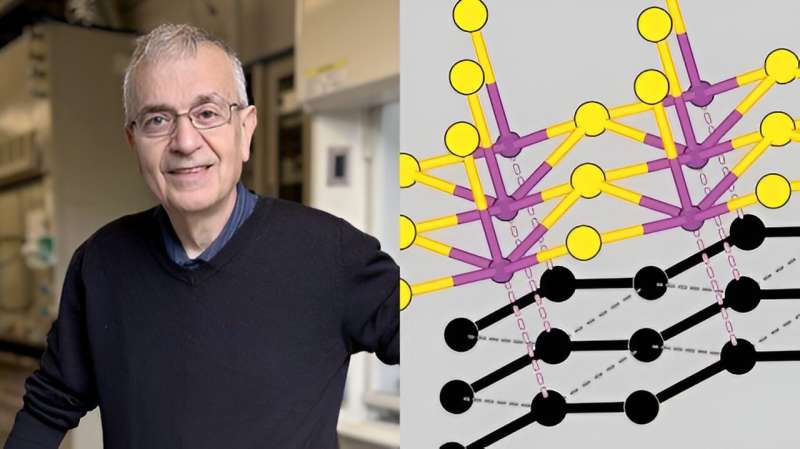This article has been reviewed according to Science X's editorial process and policies. Editors have highlighted the following attributes while ensuring the content's credibility:
fact-checked
peer-reviewed publication
trusted source
proofread
A new mineral, kanatzidisite, recognizes scientist's decades of contributions to chalcogenide chemistry

What do Mozart, Christopher Columbus and J.P. Morgan have in common? It turns out they all have minerals named after them. A new member of this exclusive club has recently been inducted: Mercouri Kanatzidis, materials scientist at the U.S. Department of Energy's (DOE) Argonne National Laboratory and professor at Northwestern University.
Kanatzidis is the namesake of a newly discovered mineral, kanatzidisite, which was recently unearthed in Hungary and announced by the International Mineralogical Society. Kanatzidisite belongs to a class of materials known as chalcogenides, which Kanatzidis has studied extensively for decades at Argonne and Northwestern. Chalcogenides are sulfur-containing materials that in antiquity were used in the production of copper metal.
"To have a mineral named after me? Well, that's a real 'rock star' moment in my career," Kanatzidis said. "It's a very unusual honor, and you hope the name will stick around a long time."
The mineral was found in the Nagybörzsöny deposit at Alsó-Rózsa, Hungary, and now can be found at the Museo di Storia Naturale, Università di Firenze, Florence, Italy. Its chemical formula is (SbBiS3)2Te2.
Kanatzidis got his start in chalcogenide chemistry as a graduate student, where he worked on sulfur-containing analogs of biological enzymes. "One of the world's most important catalytic reactions is the hydrodesulfurization of crude oil, which is a catalytic process that removes sulfur from natural gas and refined petroleum. It uses molybdenum sulfide, a major chalcogenide," Kanatzidis said. "If you take that catalyst out of the picture, our economy collapses."
According to Kanatzidis, other chalcogenides are used in solar cells and other materials. "I wanted to understand what stabilizes these compounds, and then I wanted to make new chalcogenides—to design, predict, and synthesize new materials, which I've been doing for more than 30 years," he said.
At Argonne, Kanatzidis's work has focused on the implications of chalcogenides for new potential superconductors as well as X-ray and gamma-ray detectors. "This new material could be a number of things—it might be a good thermoelectric material, which can absorb heat to create electricity. It could be a topological quantum material, which could be used for energy conversion, or even a superconductor. However, we need researchers to figure out how to make it so we have more of it to study," Kanatzidis said.
"This new material that was discovered isn't exactly something that I have ever made in the lab—it uses different building blocks," he added. "However, it has similar structural elements."
The new "building block" in the material discovered in Hungary has inspired Kanatzidis to pursue new ideas in the laboratory. "There's a loop of discovery that's emerging," he said. "There's knowledge in the geology world about what is being done synthetically in the laboratory, and the principles that are being discovered by the geologists can lead us chemists to greater heights and new discoveries."
The kanatzidisite atomic structure is reported in the Journal of the American Chemical Society.
More information: Luca Bindi et al, Kanatzidisite: A Natural Compound with Distinctive van der Waals Heterolayered Architecture, Journal of the American Chemical Society (2023). DOI: 10.1021/jacs.3c06433
Journal information: Journal of the American Chemical Society
Provided by Argonne National Laboratory





















